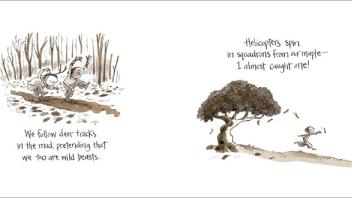Often when I mention poetry during a workshop, at least one teacher laments, “I would love to do more poetry with students, but there’s so much else to teach in my curriculum!” What I try to encourage (and I’m often helped big time by the workshop participants) is for this teacher to consider using poetry within her curriculum, as an integral part of her language, reading, and writing lessons, rather than as an add-on. In other words, I ask her to find a purpose for poetry.
Now, before you poetry purists flame me and cry out, “Poetry is in itself worth reading!” let me explain that I agree with you. I fondly recall organizing poetry picnics in third grade, where we would spread sheets and blankets on the field adjacent to the school playground and share favorite poems as we munched on morning snacks. So yes, I believe in poetry for its own sake.
But at the same time, I’m a realist. Many of us find it increasingly difficult to allocate the time to read poetry for its own sake; we would, in fact, like to discuss it beyond the month of April without needing an excuse or (shudder) a learning objective.
So increasingly it seems that while teachers can name lots of good reasons for using poetry with children at an early age , they still wonder how they can continue to integrate poetry in later grade levels. I offer a few suggestions below. And even if you can’t get through my ten reasons, do take the time to explore the recommended sites and resources appearing at the close of this post. I could in no way do justice to all the fantastic poetry books that are available, so I encourage you to share your favorite title in the comments section below.
1. Activate prior knowledge
Students are most receptive to new learning when they can connect it to what they already know. Poetry provides a quick and fun way to do this.
Recommended texts
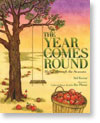
The Year Comes Round: Haiku Through the Seasons
by Sid Farrar and illustrated by Ilse Plume
This text presents students with vignettes of each season in the signature haiku 5-7-5 syllable, three line form, focusing upon nature with a surprising perspective. Each month is represented by its own poem, and students can write their own after determining what makes a poem a haiku. Students can also unearth the literary devices employed by Farrar such as personification, metaphor, alliteration, and simile. A sample from the book:

Guyku: A Year of Haiku for Boys
by Bob Raczka and illustrated by Peter H. Reynolds
Guyku stays true to the form and function of haiku, with each poem offering a funny twist in the final line. Apart from pure enjoyment, this book shows students (especially some of your hard to motivate boys) that poetry can be simple and straight forward and even fun. in “why I wrote Guyku,” Raczka says, “When I was a boy, I didn’t even know what a haiku was. But I did spend a lot of time outside with my friends. Nature was our playground, and we made the most of it — catching bugs, climbing trees, skipping stones, throwing snowballs. Now … I realize that haiku is a wonderful form of poetry for guys like us. Why? Because a haiku is an observation of nature, and nature is a place where guys love to be.” A sample from the book:
2. Establish theme
Teaching with a theme and its accompanying guiding questions isn’t new to most of us, and the majority of teachers maintain a ready repertoire of methods to establish themes for classroom novels or other literature units (see some ideas and a huge list of Universal Themes in my How to Teach a Novel Handout ). The perfect poem, however, can lead to a wonderful writing reflection or discussion that allows students to construct the theme and essential questions for themselves.
Recommended sites and texts for theme
- The Children’s Poetry Archive groups poems by themes, and my class always enjoys reflecting upon poems about death since, after all, every novel we read seems to be about death! Many poems on this site are read aloud by their authors, and my students especially love hearing The Carrion Crow read aloud.
- A common theme in upper elementary and middle school novels is Change. Encourage an in-depth study of Change using Paul Janeczko’s examination of Nothing Gold Can Stay in his new Heinemann title Reading Poetry in the Middle Grades . This highly recommended book features 20 thought-provoking poems from contemporary writers, with extensive lesson plans which help students to better understand each poem, and to apply it to other texts and their own experiences.
- Students can compose and publish their own poems using the Theme Poems interactive from ReadWriteThink.
3. Explore language
If you’re anything like me, you struggle to teach students grammar in way that is motivational or memorable. How many of us can recall learning our parts of speech and verb forms in deadly dull exercise books? While drill and example books might have a place in instruction, I’d recommend some verse to liven up the process of language learning.
Recommended sites
- If you’re seeking to help students learn parts of speech, check out the Language Adventures from Gibbs Smith. These highly engaging and hilarious books focus on discrete parts of speech through the incorporation of rhyme and humor, and later editions contain learning activities, definitions, and reproducibles related to the book’s topics.
- At The Poem Farm , Amy Ludwig VanDerwater shares wonderful original poems and teaching ideas. One of my favorites is Getting Dressed , a wonderful poem featuring personification. In addition to the many poems she shares on the site, you can have her work for your very own in her newly published collection of poems titled Forest Has a Song . In addition to the resources at Amy Ludwig VanDerwater’s site, you can also download a Houghton Mifflin Harcourt Poetry Activity Kit , featuring ideas for “Forest Has a Song” as well as several other poems from HMH titles.
- Finally, check out this Figurative Language lesson on personification and alliteration from TeachersFirst.
Recommended books
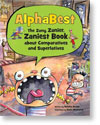
Alphabest: The Zany, Zanier, Zaniest Book about Comparatives and Superlatives
by Helaine Becker
This probably isn’t a poetry book, since each page contains just three words (such as Fuzzy, Fuzzier, Fuzziest) but it reads like poetry, and helps kids understand how adjectives can be changed to compare two or more things. Author Helaine Becker sets the scene in a busy amusement park, and illustrator Dave Whamond delivers the goods with his spirited and wacky illustrations. Students can likewise choose a single adjective, and create images to illustrate its comparative and superlative forms.
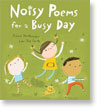
Noisy Poems for a Busy Day
by Robert Heidbreder and Lori Joy Smith
Looking for poems with onomatopoeia? Check out Noisy Poems for a Busy Day by Robert Heidbreder and Lori Joy Smith. Short and fun, and easily replicated by students. Collect all your students’ poems and create your own Busy Day anthology!
4. Focus on facts
Creating poetry is a wonderful way for students to share information they learned through class or independent study. What’s fantastic about poetry is that it can bring life to otherwise dry and lifeless facts!
I can recall assigning fourth grade students to create poems for mathematical operations, and as a class creating couplets describing the most important names, places, events, and dates for the American Revolution. Students are incredibly receptive to these challenges! So after checking out some of the examples below, be sure to devise your own lessons to have students write informational poems in class as well.
Recommended texts

Golden Domes and Silver Lanterns: A Muslim Book of Colors
by Hena Khan
In this book Hena Khan introduces young readers to the world of Islam by describing its colors and traditions in simple rhymes. Each poem serves as a definition, and the terms introduced are explained in greater detail in the book’s end. Mehrdokht Amini’s gorgeous bright and intricate illustrations make this book itself a treasure, perfect for reading with groups or sharing on a parent’s lap. A sample from the book:
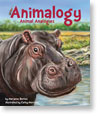
Animology: Animal Analogies
by Marianne Berkes and illustrated by Cathy Morrison
Animology introduces students to word relationships (also known as analogies) through the simplest of rhymes. Bold, full spread pictures show realistic depictions of the animals in their natural settings. Like all Sylvan Dell books, this one includes the “For Creative Minds” follow-up activities in the back of book, which can also be accessed at the publisher’s site , along with an e-book preview, a video trailer, a 48 page teaching guide , and other resources.
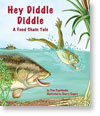
Hey Diddle Diddle: A Food Chain Tale
by Sylvan Dell
This book features a wealth of support materials for classroom instruction (see the menu bar to the right on this page ). In catchy rhyme, author Pam Kapchinske describes the the animals and complex relationships which make up a food web, the circle of life, and more specifically the ecosystem on a pond and forest habitat. Sherry Rogers’ images capture each animal playing its part in this ongoing natural cycle.
5. Set a scene
Before launching a science, social studies, or math unit, I often used poetry to set the scene. The poems I chose from myriad books would spark discussion, curiosity, and prior knowledge, ultimately building excitement and anticipation for the new unit. If only all textbooks were nearly as engaging!
Recommended texts

Water Sings Blue
by Meilo So
So, provides the denizens of the deep with their own voices, priming student curiosity about life in the ocean. One of my favorites is the poem “Old Driftwood,” wherein this artifact is described as a “gnarled sailor” … “telling of mermaids/ and whales thi-i-i-s big/ to all the attentive/ astonished twigs.” Another sample from the book:

Dark Emperor and Other Poems of the Night
by Rick Allen
This book is a perfect poetry/informational text companion to Poppy or any other novel that takes place in the forest. Each of Joyce Sidman’s wonderful poems about the nocturnal world of the woods is accompanied by a fact-filled sidebar, exploring the creatures described in the poems and in Rick Allen’s beautiful relief print illustrations. The title poem in part reads: “Perched missile, almost invisible, you preen silent feathers, swivel your sleek satellite dish of a head.”
This small excerpt gives you an idea of the book’s sophisticated verse! The author cleverly formatted the poem “Dark Emperor” in the shape of an owl, and if your students are interested in creating concrete poetry like this, you might find that shape templates are a good way to get started. And if you’re not familiar with Avi’s novel Poppy , be sure to check it out! Boys find it easy to root for this strong female character because “she is, after all, a mouse.”
6. Inspire writing
If you’re seeking ways to get students writing, poetry is an effective vehicle to transport them to success. Take the opportunity to preview Poetry Mentor Texts online at the Stenhouse site; you’ll be amazed at the simple steps to sophisticated writing using the lesson ideas presented there. In addition to Poetry Mentor Texts inspiring students to write their own verse, this book will also provide you with ideas for using poetry as a creative response format for other disciplines as well:
Recommended site
In an earlier post , I discussed writing “Valentines for Vermin” using Vulture Verses: Love Poems for the Unloved as a mentor text. The book closes with a request: “So many cards to write! So many animal friends! I may need some help. Do you know someone who is misunderstood? Will you help me write friendship notes, too?” Such a fantastic suggestion! Working in pairs or teams, students can research basic facts about other unloved animals that “scuttle, slither, buzz, and sting.” A really fun and stress free way to get students writing creatively, with results which they’ll be eager to share with others.
Recommended texts
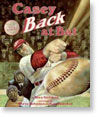
Casey Back at Bat
by Dan Gutman
Students can extend or rewrite or revisit favorite or famous poems. In Casey Back at Bat, sports writer Dan Gutman revisits the classic American poem (the picture book version illustrated by Max Payne is one of my favorites). Choose similar narrative poems, and challenge students to extend them, revise them, or “answer them” with poems of their own.
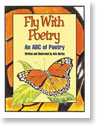
ABCs of Poetry
by Avis Harley
If you’re seeking inspirations for students to write poetry in a number of forms, you’ll be amazed and delighted to read Fly with Poetry: An ABC of Poetry or Leap Into Poetry: More ABCs of Poetry . First, it’s amazing that author/illustrator Avis Harley has found enough poem forms to write and illustrate not just one but two ABC collections, and second, she’s done it by focusing solely on the topic of insects! So she not only presents and explains the poetry forms in detail, but these mentor texts teach students wonderful facts about dozens of creatures that crawl, climb, and fly as well. Extensions using other animal species are possible, although I can see these form poems being applied to almost any subject area.
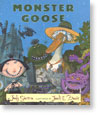
Monster Goose
by Judy Sierra
Students love the idea of fractured fairy tales, so a book like Monster Goose by Judy Sierra is certain to be hit. The author’s creepy and comedic new versions of classic childhood rhymes will inspire your students to want to create the same. After sharing a few poems such as Humpty Dumpty (below), provide students with a collection of unrevised rhymes, and see where their imaginations can take them. See, too, if their accompanying illustrations can be as entertaining as those of Jack E. Davis, illustrator extraordinaire of Bedhead fame. Davis not only captures a key moment of each poem, but also cleverly establishes and then breaks the borders of each illustration, creating an off-the-page effect.
7. See new perspectives
One of poetry’s transcendent powers is its ability to refocus, if not totally transform, our point of view. It’s far too simple for students (and teachers!) to lose themselves in their egocentric viewpoints, and fail to consider issues from another perspective. Poetry open students’ eyes to new ways of seeing.
Recommended texts
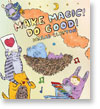
Make Magic! Do Good!
by Dallas Clayton
A quirky and crazy collection of verses that collectively encourage readers to see the best in themselves, in others, and in every situation. So much of modern day communication relies upon snark and sarcasm, it’s refreshing to find poems that are open and honest and encouraging, while at the same time remaining zany and random, which kids also appreciate. I also think that the way the book cover turns into a poster is a pretty cool twist!

Paul Revere’s Ride
by Henry Wadsworth Longfellow
Perspective, or point of view, plays a huge role in history and its interpretation. Although not entirely accurate in historic detail, Henry Wadsworth Longfellow’s The Midnight Ride of Paul Revere remains a classic of American Literature. Check out this previous post where I discuss several picture versions of the text, and the unique perspective supplied by each.
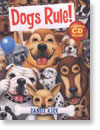
Dogs Rule!
by Daniel Kirk
In Daniel Kirk’s Dogs Rule! and his later Cat Power! , the author/illustrator profiles some of the furriest and funniest heroes of each species. See my Words and Images in Perfect Harmony post for more details, as well as teaching suggestions.
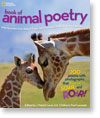
Book of Animal Poetry
by National Geographic
The National Geographic’s Book of Animal Poetry is wonderful in that it often features multiple poems for a single animal. The zebra and the pig, for instance, are both celebrated by four different poets. Examining the poems, students can discuss what facts and features each poet chose to discuss. In what ways are their poems alike? Different? Older students can even attempt to identify the poem form used by each writer. After reading some of the examples in this book from both classic and contemporary writers, students can then try their own hand at describing animals both foreign and familiar. Such poems are an excellent addition to those animal reports and presentations which many teachers already include in their curriculum.
8. Ignite curiosity
Much has been said in educational texts about inquiry learning. From my own experiences, however, I find that students are naturally inquisitive, and there’s not much more we need to do but focus their natural curiosity. Poetry can do this!
Recommended texts
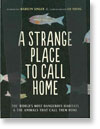
A Strange Place to Call Home
by Marilyn Singer
This is an intriguing exploration into diverse and unique habitats of the world. In the preface, the author explains: “Extreme environments such as deserts, glaciers, salt lakes, and pools of oil may not seem appealing, yet in these places, there is often less competition and more safety from predators. So over time, a variety of animals have adapted to these challenging conditions. This collection of poems celebrates some of these great adapters and the risky places where they live.” End notes give further explanation of each animal and its adaptations to its specialized niche, along with notes about the poetry forms employed for each piece. Below is a sample poem, written in sonnet form:
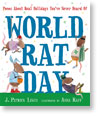
World Rat Day
by J. Patrick Lewis
A fun collection of unusual but authentic holidays, celebrated here in verse. Where else could you learn about Cow Appreciation Day, Limerick Day, or Chocolate-Covered Anything Day? Students will enjoy researching these and other wacky holidays, and even inventing their own to commemorate people, places, and events that are important to them. (See a video trailer here at the Candlewick Press site).
9. Provide pleasure
Okay, so you may think I cheated on this one. After all, I’m supposed to be giving you purposes for using poetry. But if we can’t convince our students that one of reading’s purest functions is pleasure, then I don’t think we’ve really done our job.
So many poems and books of poems exist to fill this classification that I won’t even begin to list them all here. So if you have a favorite poem or book you read with students for pleasure, please share it in the comments section below!
Recommended texts
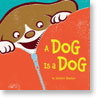
A Dog is a Dog
by Stephen Shaskan
This book is an incredibly simple, yet funny and clever book about a dog who may not be a dog at all, but perhaps instead a cat … or is it a squid? … or a moose? This crazy dog sheds one disguise after another, and who knows what he’ll be next? It’s short, fun, and you’d better be prepared to read it more than once, although its simplicity, meter, and rhyme make it easily accessible to independent beginning readers. Also be sure to check out the cool stuff on the author’s site .
10. Capture character
Most of us have assigned biography reports, only later to be disappointed when some students fail to capture the greatness of the men and women they studied. What’s awesome about biographical poems is that they encapsulate the essence of what makes a person’s life memorable and meaningful.
Recommended sites
Use the The Explorers’ Graveyard lesson plan for sharing facts and findings when reading biographies. Again, the aim here is to get to what’s worth knowing about this famous person.If you’re looking for a funnier take of epitaphs, I recommend Once Upon a Tomb: Gravely Humorous Verses by J. Patrick Lewis (yes, him again!), and illustrated by Simon Bartram. The hilarious and revealing tombstone tidings capture in the most clever way the humor of many professions. Take this one, for instance, written for a Book Editor:
Recommended texts
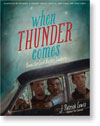
When Thunder Comes: Poems for Civil Rights Leaders
by J. Patrick Lewis
A satisfying mix of heroes and heroines from the world-wide struggle for human rights. Familiar names such as Jackie Robinson, Harvey Milk, and Mohandas Gandhi share the pages with new discoveries such as Sylvia Mendez (Mexican-American-Purto Rican civil rights leader), Muhammad Yunus (Bangladeshi banker), and Dennis Banks (Cofounder of the American Indian Movement and Anishinabe political activist). Several artists collaborate to illustrate the poems, which can also lead to a discussion of what each artist chose to represent the whole of a person’s life in a single image. For more teaching ideas integrating these poems with informational writing, see the related post at Two Writing Teachers blog .
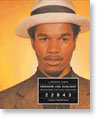
Freedom Like Sunlight: Praisesongs for Black Americans
by J. Patrick Lewis
These poems are notable in that they capture the content of each person’s character, rather then the rote facts of his or her life. John Thompson’s realistically rendered illustrations help to make this title a standout.
Recommended online tools for writing poetry
- Rhyme Brain isn’t just another rhyming site; instead, it has three functions: rhyme creator, alliteration creator, and portmanteau creator. The results for the latter two tools are pretty impressive, and lend themselves to some real playfulness with language.
- At WriteRhymes , it’s as easy as “As you write, hold the alt key and click on a word to find a rhyme for it … ” That’s it. You can Copy, Save, or Print from the site.
Recommended resources for poetry month
- Stenhouse Publishing has compiled a wonderful collection of poetry lesson plans and teaching ideas from about a dozen of their best-selling professional resources. Check out the Poetry Sampler , available as a pdf download directly from the publisher.
- ReadWriteThink is a go-to resource if you’re seeking poetry lesson plans complete with interactive or printable components. From the search page, you can narrow down the 285 results by grade level, resource type, or popularity.
- If needed, here’s an extensive glossary of poetry terms . I wish each term was accompanied by an example, but a good place to start regardless. If you can’t find a term there, then you can likely find it in this Glossary of Poetic Terms .
- The Children’s Poetry Archive is a wonderful collection of poems selected just for children, and read by their creators.
- Tweenverse is a fun collection of poems by Richard Thomas. No activities included here, but you’ll several of these to be perfect as mentor texts for helping students write verse to reflect on their own experiences. See Summer Camp Souvenirs or Brother Trouble for a quick idea of what you’ll find there.
- The Poets.org Educator Site provides teaching tips, popular poems to share, curriculum units and lesson plans, and suggestions for Poetry Month.
- Poetry for Tough Guys features poems written by Steven Micciche, mostly aimed at guys. Don’t worry; it’s still kid appropriate! Perhaps a good stop for reluctant boys to gain entry into verse.
Keith Schoch is an educator, presenter, and advocate for reading. This article was published on his blog, Teaching with Picture Books . He also shares resources and recommendations through two other blogs: Teaching that Sticks and How to Teach a Novel .
